Final report for FNE17-869
Project Information
The purpose of this project was to assess the feasibility of growing litchi tomato, Solanum sisymbriifolium, as a novel small-fruited crop in southern New England. Greenhouse and field trials were set up to look into preferred dates for seeding, need for acid scarification of seeds, and soil temperature. Field trials measured fruit yield and labor input. The second year of the study assessed weediness potential. The results of this project indicate that litchi tomato does not have potential for being a viable crop in southern New England. While successful greenhouse propagation protocols were established - unscarified seeds that had been fermented when saved from the previous harvest, sown in late March with 80 degree bottom heat - field plantings produced very low yields of 0.66 - 1.07 lbs of fruit per 10 plants per picking, which was labor intensive at approximately 15 minutes per 10 plants. Undesirable fruit quality variability and insect pest pressure were also found to be problematic. The weediness assessment showed that litchi tomato can build a seed bank in the soil. In a 400 sqft plot adjacent to the first year's planting, 11 self sown plants produced an average of 88 mature fruits, with an average of 124 seeds per fruit. Outreach for this project was conducted through regional farmer and agricultural educator listserves and small farmer and seed saving social media sites.
The goal of this project was to make a preliminary examination of the feasibility of litchi tomato as a novel niche crop. There were two primary goals, to explore best-methods for production and to assess the possibility of litchi tomato becoming a weed problem. I conducted greenhouse germination trials to better understand when to start seeds for maximum yields and also to test if acid scarified seeds or soil temperature affected germination. Seedlings were planted out in the field in a randomized block design, and I collected growth, yield and labor input data. To assess weed risk, in the second year of the project a small plot adjacent to the first year's planting was assessed for self-sown seedlings, which were then monitored for fruit maturation.
Small fruits and berries, especially organically grown, are a big draw at farmers’ markets and CSA’s. However, many of these crops can have significant start up costs, may take many years to bear profitably, and can be challenging to grow, notably for new farmers who are trying to master the many components of a mixed vegetable operation. Through this project, litchi tomato, Solanum sisymbriifolium, was assessed as an ‘easy-entry’ small fruit for vegetable growers in the Northeast. We had grown several plants on our farm in the past, and CSA members who sampled the fruit universally liked them, comparing their flavor to rose hips, cherries or raspberries, and said they’d be excited to have litchi tomato as an offering in our CSA. Novel fruit offerings could help boost farmers’ market sales and build customer loyalty, as well as make CSA offerings more robust and attractive to new members.
Our farm, in northeastern Connecticut, is a small mixed vegetable operation on six acres, two cultivated, marketed through a ~50 member CSA, a farmers’ market, and a local food cooperative. We also have a flock of laying hens and raise a limited number of boiler chickens and turkeys. Small fruits are a missing component of our CSA offerings, and local farmers’ markets are often undersupplied in fruit. Our customers prefer organic production, yet we don’t live in a particularly high income area, so profitability of small fruits can be challenging, given the high labor costs and perishable nature of small fruits. Having small fruits to offer would make our CSA more robust, as well as be a nice draw for customers at farmers’ market. We felt that litchi tomato had potential as a new crop because of low start-up costs, ability to harvest in the first year, and long harvest window. Additionally, fruit seems to hold well at room temperature, in addition to being quite tasty.
Preliminary research into how to best grow the plants, data on yields and harvest labor, and an assessment of weed risk were our first steps in determining the viability of litchi tomato as a specialty crop. Very little information is available for growing litchi tomato for fruit, and most of it is anecdotal. I had not been able to find any technical information. Articles in gardening magazines describe litchi tomato as prolific and easy to grow, yet online comments for seed companies and gardening blogs report varying success with germination, yields and flavor. One goal of this study was to establish germination protocols that maximize yields, and to assess yield and labor inputs.
Regarding the potential weediness of litchi tomato, weed risk assessment modeling has been conducted by USDA-APHIS in response to potato growers interest in S. sisymbriifolium as a catch crop for potato cyst nematodes. The modeling categorized litchi tomato as high risk, in part due to the reported ease by which it spreads into disturbed habitat, that it is already established in 17 states, and that several other members of the genus are problematic weeds in the US. Litchi tomato is also a reported weed of rangeland in South Africa and Australia. However, while the plant is reported from our neighboring states of New York and Massachusetts (no records for CT), it is very uncommon. It is reported from four counties in New York, and three counties in Massachusetts. The most recent record found for Massachusetts was from 1955. Given that litchi tomato has occurred in the Northeast for decades yet not become problematic, one could conclude that it’s weed risk potential for our region is low. Additionally, litchi tomato is being used on a commercial scale in the Netherlands and England to control potato cyst nematodes, and I have not found reports of it becoming a problematic weed. (It is possible, however, that the plants get turned into the soil before producing viable seeds.) It is also noteworthy that litchi tomato is native to Brazil, so while it can be a persistent weed in some areas, our winters are too cold for the vegetative plant to survive beyond one year. Yet given the APHIS modeling, and that the plants are heavily armored with spines, making for a very unpleasant weed, a field assessment of potential weediness seemed prudent. Assessing weed risk is important in protecting natural resources (surrounding native ecosystems), as well as trying to ensure that the plant doesn’t become a management problem on farms.
Cooperators
- - Technical Advisor (Researcher)
Research
Greenhouse germination trials, 2017:
In regard to seed starting protocols, three different variables were tested – timing of seed sowing, acid scarification of seeds, and soil temperature for germination. There were two sowing dates, and scarification was tested within the first date and soil temperature was tested within the second planting date. For all treatments, seeds were sown into ~1 ½” square soil blocks, 2 seeds per block, 50 blocks per tray, thus 100 seeds per treatment. Unless noted, all trays were on heat mats set for 80 degrees. All seeds used in this project were seed-saved from the farm, and were fermented as for tomatoes.
To determine preferred time for starting the plants, seeds were started on two dates, in the third week of March and the third week of April. After four weeks (late April), the heights of the March seedlings were recorded and 20 of the control seedlings were transplanted into quart containers. In early June, before transplanting to the field, the heights of the March plants and April plants were recorded. (April plants went directly into the field as soil blocks.)
To test for the effectiveness of acid scarification on germination rates, seeds were soaked in commercially available muriatic acid (HCl). There were four treatments within the March sowing – soaking seeds for 2 hrs, 4 hrs, 6 hrs, and a control. After soaking, seeds were rinsed for one minute in running water then dried on paper plates. Germination rates for the four treatments were recorded over the course of 23 days.
Soil temperature effects on germination were tested within the April sowing. There were two treatments, one heated tray on the heat mat set at 80 degrees, and one unheated tray. (The ambient temperature in the greenhouse ranged between 54-95 degrees.) Germination rates were recorded for 28 days, and plant height was recorded at the end of the 28 days.
Within the first week of June, all plants were removed from the greenhouse and hardened off before transplanting to the field.
Field trials, 2017:
Twenty plants each from the March control treatment and the April heated treatment were planted to the field in the first week of June. Soil was amended with 2-year-old dairy manure, which was tilled in. The forty plants were planted in a randomized block design of two rows, 8’ between rows and 4’ between plants. No stakes were used. In late September fruit yield data was collected, recording harvest weights and labor hours.
Weediness assessment, 2018:
An 8’ X 50’ section of field that was adjacent to the previous year’s litchi tomato planting was monitored for weed-seedlings and fruit set. As one might for a bare-soil crop, the patch was tilled in the spring, cultivated once, and then left so we could see what grew. The block was hoed out several times mid-season, around the litchi tomatoes, to prevent other weeds from setting seed. The number of plants, total number of mature fruits per plant, and a sampling of seeds/fruit was recorded.
Greenhouse germination trials:
All told, March-planted, untreated seeds started on the heat mat worked out the best.
Looking at the difference between plants started in March or April, March plants were larger at field transplanting time, blossomed earlier, and had a higher yield. (Note that no sample sizes where large enough to be statistically significant.) Of the ten March control plants measured at 33 days from planting, heights ranged from 5.1 to 8.8 cm, with an average of 6.5 cm. At 80 days from planting, the plants ranged from 46.1 cm to 60.2 cm with an average of 54.5 cm. For the plants started in April, sampled at 47 days from planting, the unheated treatment ranged from 4.3 cm to 7.0 cm with an average of 5.7 cm; the heated treatment ranged from 6.0 cm to 11.4 cm with an average of 8.9 cm. (Bloom time and yield in the field trial section.)
Acid scarification did not improve germination rates. As the table shows, acceptable germination rates were achieved in the March planting with untreated seeds on a heat mat, whereas the longest soak probably killed the seeds. When researched litchi tomatoes before starting this project, I found several anecdotal references to poor germination for the plant, thus the scarification test. However, it is possible that commercially available seed is in the raw state, whereas our seed had been fermented and washed before drying and storing. It is possible that litchi tomatoes seeds have a germination inhibitor like tomatoes, and fermenting the seed as with tomatoes increases germination rate.
|
Untreated |
66% |
75% |
77% |
77% |
|
2 hr soak |
18% |
28% |
49% |
51% |
|
4 hr soak |
0 |
0 |
6% |
27% |
|
6 hr soak |
0 |
0 |
0 |
0 |
|
(days from sowing) |
8 days |
10 days |
14 days |
25 days |
Seeds on the 80 degree heat mat germinated more quickly than those at ambient greenhouse temperatures. For the April planting, seeds on the heat mat began germinating eight days after planting whereas the unheated seeds did not begin germinating until 17 days after planting. (In this case, by germination I mean seedling emergence from the soil.) Twenty days after planting, 68% of the unheated seeds were up, but were only cotyledons, whereas 76% of the heated seeds had germinated and most had developed their second set of true leaves. Fifty days after planting, 72% of the unheated seeds had germinated and 77% of the heated seeds germinated. So in the end, the heat mat did not increase overall germination significantly, but did increase the speed of germination, thus resulting in larger plants sooner. At 50 days after planting, plants in the unheated tray ranged from 4.3 cm to 7.0 cm with an average of 5.8 cm, while the heated plants ranged from 6.0 cm to 11.4 cm with an average of 8.9 cm.
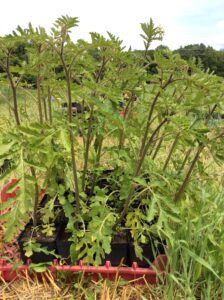
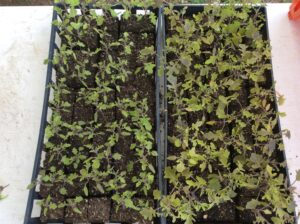
Field trials:
Overall, field performance of litchi tomato was disappointing. Yields were very low, picking was very inefficient, fruit quality was highly variable, and Colorado potato beetle and tobacco hornworm were notable pests.

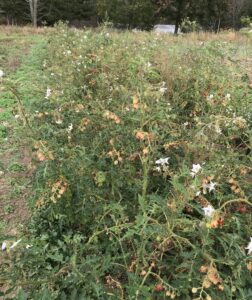
Given the low yields, and need to tend to other farm tasks, the planting was only picked clean once in late September. For perspective, at the time tomatoes and peppers were still bearing well, so the late September harvest would have been reflective of most of the harvest window. From the first block of ten March planted individuals, 0.75 lbs of marketable fruits were harvested; from the second March planted block, 1.07 lbs. From the first block of ten April planted individuals, 0.67 lbs were harvested; from the second March planted block, 0.66 lbs. It took approximately 15 minutes to pick each of the four blocks. Not one of the four blocks yielded a full quart.
In retrospect, maybe a tissue analysis, using another Solinaceous crop as a standard, might have indicated a nutritional deficiency that led to low yields, but tomatoes and peppers usually do quite well for us, and we amended generously with aged manure, so I’m left to believe that litchi tomatoes aren’t likely to bear well under normal field conditions. Colorado potato beetles (CPB) and tobacco hornworms (THW) were also problematic pests, neither of which normally cause widespread damage on the farm. I never formally assessed CPB damage, but I’d estimate they defoliated up to 50% of new growth on some individual plants. On one afternoon, I counted 17 THW on the 40 plants, whereas over the course of a season I normally only find a few THW on our over-200 tomato plants. In addition to eating leaves, it seemed that both the CPB and THW would chew on the fruits, which would then scar over and be unmarketable. On a positive note, given litchi tomatoes attractiveness, it might be a good catch crop for CPB and THW.
Sampling fruits in the field over the course of the season, there was a high degree of variability in fruit quality. Some plants produced easy-to-pick, full succulent fruits with a rich flavor suggestive of raspberries, rose hips, and something tropical. Some plants produced dry, bland fruits. Others didn’t release their fruits. The spiny calyxes stayed wrapped around the ripe fruit or the plant would “hold” the fruit – a clean abscission layer didn’t develop and the fruits tore when picked. To the best of my knowledge, no selection has been done on litchi tomato. The plants grown on the farm were similar to what would be found in the wild in Brazil. Like any wild plant, there is a lot of genetic variability, and so possibly selection could be done within a large enough population to stabilize desirable fruit traits which already exist within the population, but increasing yield or insect resistance or decreasing spininess would be a more challenging breeding project.
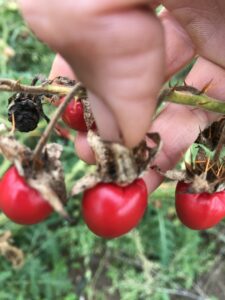
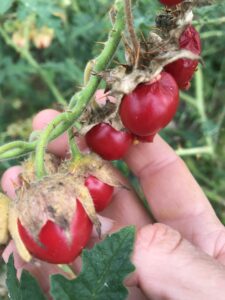
Weediness assessment:
In Connecticut, litchi tomato has the possibility of establishing itself as an annual weed with a viable seedbank. During the second year of the project, 11 litchi tomato plants grew within the 400 sqft area immediately adjacent to the previous year’s planting. One of the plants did not produce mature fruits, but ten of them did, with number of mature fruits ranging from 14 to 207, with an average of 88 fruits per plant. There was an average of 124 seeds per fruit. Litchi tomatoes have weak seedlings that are easy to kill with cultivation, so I don’t see it as a weed problem within a vegetable field, but it could be an unfortunate weed to have established within perennial beds, unkempt edges or in pasture.
The goal of this project was to assess the feasibility of litchi tomato as a novel small-fruit crop for small farms. While a successful seed-starting protocol was established, field assessment of a small planting determined that litchi tomato is not a viable niche crop for southern New England. Extremely low yields, slow picking, fruit quality variability between plants, and insect pest pressure all make litchi tomato an unlikely candidate as an alternative small-fruit crop. Additionally, the fact that litchi tomato can establish a seed bank in the soil and become an annual weed should give farmers pause before introducing the plant to their farms.
Education & Outreach Activities and Participation Summary
Email through UConn extension listserv and CT New Farmer Alliance network.
Total reach was at least 147 people.
Participation Summary:
As above, including a walk-through with local farmers, plus another recent SARE grant recipient and I are exploring the possibility of presenting a how-to-apply-to-SARE mini-workshop in the fall of 2019.
Learning Outcomes
The primary learning outcome of this project was that litchi tomato is not a viable new crop for southern New England. While I might continue to grow a few plants in spots where seed spread won't be an issue, the amount of time (about an hour), plus the area (about 800 sqft) needed to harvest less than four quarts of fruit per picking does not justify growing litchi tomato on a commercial scale.
Hopefully, through outreach, other farmers will also become aware of SARE funding as a valuable asset in being able to test out new ideas on their farms.
Project Outcomes
As my results were negative, there were no direct benefits from my project, but through outreach we've increased awareness of the availability of SARE funding, and a number of non-farming readers seemed to gain an appreciation for all the work that goes into farming.
In retrospect, overall my approach to studying the feasibility of litchi tomato as an agricultural crop seemed appropriate, and I answered the questions I initially proposed. One factor I hadn't taken into account when designing the study was the possibility of variability between seed sources, and were I to redo the study I would trial seed from a numerous seed sources, if available. I have not, however, in my research, found any indications of selections being made to improve upon the wild species.
The results of this study might be most useful to home gardeners, rather than farmers. Litchi tomato isn't a feasible agricultural crop, but it is horticulturally interesting, and can be quite delicious, so backyard growers could find both the propagation techniques and weediness risk assessment useful.